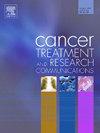脑转移管理的全身治疗突破:her2阳性乳腺癌的新时代。
IF 2.4
Q3 Medicine
引用次数: 0
摘要
her2阳性亚型占转移性乳腺癌(mBC)病例的15- 20%,并与脑转移(BMs)的高发相关,影响35- 50%的患者,导致预后不良。尽管her2靶向治疗显著提高了总生存率(OS),但由于血脑屏障(BBB)限制了全身治疗效果,中枢神经系统(CNS)受累仍然是一个重大挑战。抗体-药物偶联物(adc)的出现带来了具有中枢神经系统活性的有希望的治疗选择。这篇叙述性综述综合了目前关于her2阳性脑转移的全身治疗的证据。全面的文献检索包括PubMed、ASCO、ESMO和NCCN指南,以及ClinicalTrials.gov上正在进行的试验。直到最近,HER2CLIMB方案——联合图卡替尼、曲妥珠单抗和卡培他他——是控制中枢神经系统疾病最有效的选择,实现了9.9个月的中位中枢神经系统无进展生存期(PFS)。然而,最近的试验强调了抗体-药物偶联物(adc)在这种临床环境中的变革性影响,特别是曲妥珠单抗德鲁德康(T-DXd)。DESTINY-Breast试验的汇总分析报告,未治疗脑转移患者颅内总缓解率(ICORR)为45.5%,治疗脑转移患者为45.2%。较小的研究,如DEBBRA和TUXEDO-1,显示icorr分别为66.7%和73.3%,TUXEDO-1报告的中位PFS为14个月。III/IV期DESTINY-Breast12试验进一步验证了T-DXd对活动性脑转移的疗效,CNS PFS为17.3个月,ICORR为62.3%,其中未治疗脑转移的疗效最高(82.6%)。目前的分析回顾了管理脑转移的现有数据,并强调了T-DXd重新定义治疗策略的潜力。它还讨论了未解决的问题,如放射治疗在无症状疾病中的作用和adc的发展前景。本文章由计算机程序翻译,如有差异,请以英文原文为准。
Systemic therapy breakthroughs in the management of brain metastases: A new era for HER2-positive breast cancer
HER2-positive subtype accounts for 15–20 % of metastatic breast cancer (mBC) cases and is associated with a high incidence of brain metastases (BMs), which affects 35–50 % of the patients, contributing to poor outcomes. Although HER2-targeted therapies have significantly improved overall survival (OS), central nervous system (CNS) involvement remains a significant challenge due to the blood-brain barrier (BBB), which limits systemic treatment efficacy. The advent of antibody-drug conjugates (ADCs) has introduced promising therapeutic options with demonstrated CNS activity.
This narrative review synthesizes current evidence on systemic treatments for HER2-positive BMs. A comprehensive literature search included PubMed, ASCO, ESMO, and NCCN guidelines, as well as ongoing trials from ClinicalTrials.gov.
Until recently, the HER2CLIMB regimen—combining tucatinib, trastuzumab, and capecitabine—was the most effective option for CNS disease control, achieving a median CNS progression-free survival (PFS) of 9.9 months. However, recent trials highlight the transformative impact of antibody-drug conjugates (ADCs), particularly trastuzumab deruxtecan (T-DXd), in this clinical setting. Pooled analyses from the DESTINY-Breast trials reported intracranial overall response rates (IC![]() ORR) of 45.5 % in untreated and 45.2 % in treated BMs. Smaller studies, such as DEBBRA and TUXEDO-1, demonstrated IC
ORR) of 45.5 % in untreated and 45.2 % in treated BMs. Smaller studies, such as DEBBRA and TUXEDO-1, demonstrated IC![]() ORRs of 66.7 % and 73.3 %, respectively, with TUXEDO-1 reporting a median PFS of 14 months. The phase III/IV DESTINY-Breast12 trial further validated T-DXd’s efficacy in active BMs, achieving a CNS PFS of 17.3 months and an IC
ORRs of 66.7 % and 73.3 %, respectively, with TUXEDO-1 reporting a median PFS of 14 months. The phase III/IV DESTINY-Breast12 trial further validated T-DXd’s efficacy in active BMs, achieving a CNS PFS of 17.3 months and an IC![]() ORR of 62.3 %, with the highest responses (82.6 %) in untreated BMs.
ORR of 62.3 %, with the highest responses (82.6 %) in untreated BMs.
The current analysis reviews the available data on managing brain metastasis and highlights T-DXd's potential to redefine treatment strategies. It also discusses unanswered questions, such as the role of radiotherapy in asymptomatic disease and the evolving landscape of ADCs.
求助全文
通过发布文献求助,成功后即可免费获取论文全文。
去求助
来源期刊

Cancer treatment and research communications
Medicine-Oncology
CiteScore
4.30
自引率
0.00%
发文量
148
审稿时长
56 days
期刊介绍:
Cancer Treatment and Research Communications is an international peer-reviewed publication dedicated to providing comprehensive basic, translational, and clinical oncology research. The journal is devoted to articles on detection, diagnosis, prevention, policy, and treatment of cancer and provides a global forum for the nurturing and development of future generations of oncology scientists. Cancer Treatment and Research Communications publishes comprehensive reviews and original studies describing various aspects of basic through clinical research of all tumor types. The journal also accepts clinical studies in oncology, with an emphasis on prospective early phase clinical trials. Specific areas of interest include basic, translational, and clinical research and mechanistic approaches; cancer biology; molecular carcinogenesis; genetics and genomics; stem cell and developmental biology; immunology; molecular and cellular oncology; systems biology; drug sensitivity and resistance; gene and antisense therapy; pathology, markers, and prognostic indicators; chemoprevention strategies; multimodality therapy; cancer policy; and integration of various approaches. Our mission is to be the premier source of relevant information through promoting excellence in research and facilitating the timely translation of that science to health care and clinical practice.
 求助内容:
求助内容: 应助结果提醒方式:
应助结果提醒方式:


